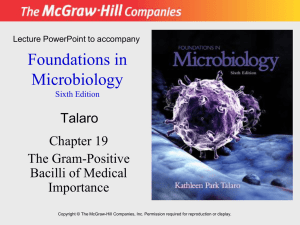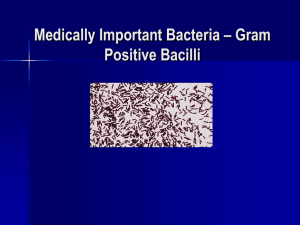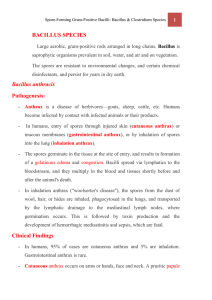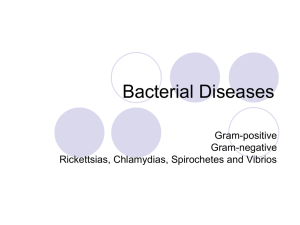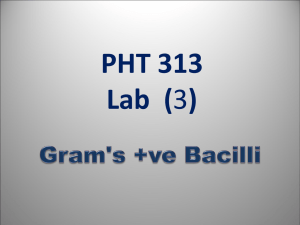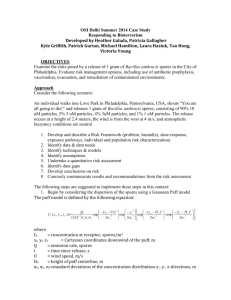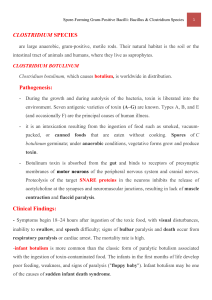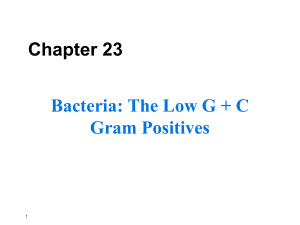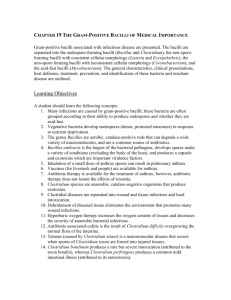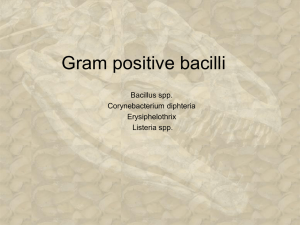Chapter 19 - eacfaculty.org
advertisement
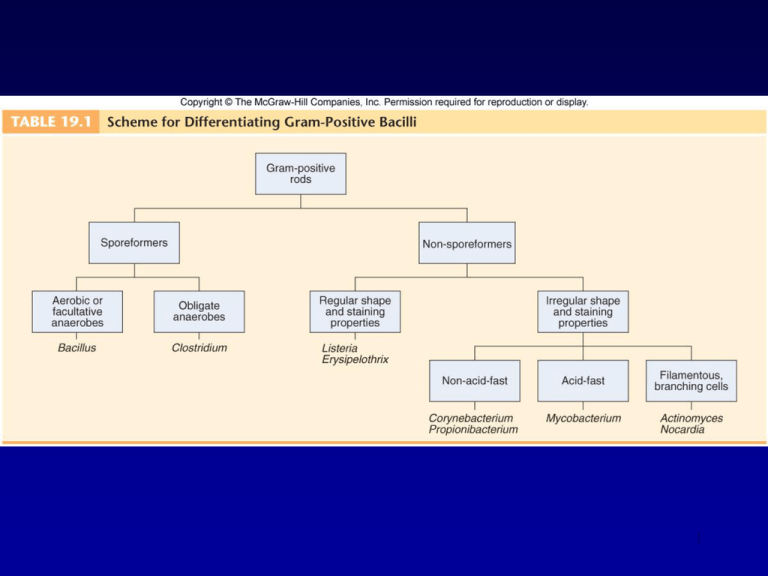
1 Spore-forming Bacilli Genus Bacillus Genus Clostridium 2 3 Bacillus • gram-positive, endospore-forming, motile rods • mostly saprobic • aerobic & catalase positive • source of antibiotics • primary habitat is soil • 2 species of medical importance – Bacillus anthracis – Bacillus cereus 4 Bacillus anthracis • large, block shaped rods • central spores that develop under all conditions except in the living body • virulence factors – capsule & exotoxins • 3 types of anthrax – Cutaneous – spores enter through skin, cause black sore (eschar); least dangerous – Pulmonary –inhalation of spores – Gastrointestinal – ingested spores • treated with penicillin or tetracycline • vaccine – toxoid 6X over 1.5 years; annual boosters 5 6 Bacillus cereus • common airborne & dustborne • grows in foods, spores survive cooking & reheating • ingestion of toxin-containing food causes nausea, vomiting, abdominal cramps & diarrhea; 24 hour duration • no treatment • spores abundant in the environment 7 Clostridium • • • • gram-positive, spore-forming rods anaerobic & catalase negative 120 species oval or spherical spores produced only under anaerobic conditions • synthesize organic acids & alcohols & exotoxins • cause wound & tissue infections & food intoxications 8 Clostridium perfringens • causes gas gangrene in damaged or dead tissues • 2nd most common cause of food poisoning, worldwide • virulence factors – alpha toxin: causes RBC rupture, edema & tissue destruction – collagenase – hyaluronidase 9 – DNase Pathology of C. perfringens • Not highly invasive; requires damaged and dead tissue and anaerobic conditions • Conditions stimulate spore germination, vegetative growth and release of exotoxins, and other virulence factors • Fermentation of muscle carbohydrates results in the formation of gas and further destruction of tissue 10 11 12 Treatment of Gangrene • Immediate cleansing of dirty wounds, deep wounds, decubitus ulcers, compound fractures, and infected incisions • – debridement of diseased tissue – large doses of cephalosporin or penicillin – hyperbaric oxygen 13 Clostridium difficile • normal resident of colon, in low numbers • causes antibiotic-associated colitis – treatment with broad-spectrum antibiotics kills the other bacteria, allowing C. difficile to overgrow • produces enterotoxins that damage the intestine • major cause of diarrhea in hospitals 14 Treatment and Prevention of CDAC • Mild uncomplicated cases respond to fluid and electrolyte replacement and withdrawal of antimicrobials • Severe infections treated with oral vancomycin or metronidazole and replacement cultures • Increased precautions to prevent spread 15 Clostridium tetani • common resident of soil & GI tracts of animals • causes tetanus or lockjaw • spores usually enter through accidental puncture wounds, burns, umbilical stumps, frostbite, & crushed body parts • tetanospasmin – neurotoxin causes paralysis 16 17 Treatment and Prevention • Treatment aimed at deterring degree of toxemia and infection and maintaining homeostasis • Antitoxin therapy with human tetanus immune globulin; inactivates circulating toxin but does not counteract that which is already bound • Control infection with penicillin or tetracycline • Vaccine available; booster needed every 10 years 18 Clostridium botulinum • food poisoning -spores are in soil, may contaminate vegetables; improper canning does not kill spores & they germinate in the can, producing botulin toxin – toxin causes paralysis by preventing release of acetylcholine • infant botulism – caused by ingested spores that germinate & release toxin • wound botulism – spores enter wound & cause food poisoning symptoms 19 20 21 22 Treatment and Prevention • Determine presence of toxin in food, intestinal contents or feces • Administer antitoxin; cardiac and respiratory support • Infectious botulism treated with penicillin • Practice proper methods of preserving and handling canned foods; addition of preservatives 23 Listeria monocytogenes • • • • • non-spore-forming gram-positive ranging from coccobacilli to long filaments no capsules resistant to cold, heat, salt, pH extremes & bile virulence attributed to ability to replicate in the cytoplasm of cells after inducing phagocytosis; avoids humoral immune system • can contaminate foods & grow during refrigeration • Listerosis in immunocompromised patients, fetuses & neonates affects brain & meninges – 20% death rate • ampicillin & trimethoprimsulfamethoxazole • prevention – pasteurization & cooking 24 Corynebacterium diphtheriae • • • • gram-positive irregular bacilli produce catalase uses respiratory portal virulence factors assist in attachment and growth – diphtherotoxin – exotoxin • 2 part toxin – part B binds and induces endocytosis; part A arrests protein synthesis • 2 stages of disease – local infection – upper respiratory tract – diptherotoxin production & toxemia • pseudomembrane formation can cause asphyxiation 25 26 27 28 Mycobacteria • • • • • • • • • gram-positive irregular bacilli acid-fast staining strict aerobes produce catalase possess mycolic acids & a unique type of peptidoglycan do not form capsules, flagella or spores grow slowly Mycobacterium tuberculosis Mycobacterium leprae 29 30 Mycobacterium tuberculosis • produces no exotoxins or enzymes that contribute to infectiousness • contains complex waxes & cord factor that prevent destruction by lysosomes of macrophages • transmitted by airborne respiratory droplets • only 5% of infected people develop clinical disease 31 Primary TB • infectious dose 10 cells! • phagocytosed by alveolar macrophages & multiply intracellularly • after 3-4 weeks immune system attacks, forming tubercles, granulomas consisting of a central core containing bacilli surrounded by WBCs 32 33 Secondary TB • reactivation of bacilli • tubercles expand & drain into the bronchial tubes & upper respiratory tract • gradually patient experiences more severe symptoms – violent coughing, greenish or bloody sputum, fever, anorexia, weight loss, fatigue • untreated 60% mortality rate 34 Extrapulmonary TB during secondary TB, bacilli disseminate to regional lymph nodes, kidneys, long bones, genital tract, brain, meninges Diagnosis of TB • • • • in vivo or tuberculin testing X-rays direct identification of acid-fast bacilli in specimen cultural isolation and biochemical testing 36 37 X-ray of Secondary Tubercular Infection 38 Treatment of TB • 6-24 months of at least 2 drugs from a list of 11 • one pill regimen called Rifater (isoniazid, rifampin, pyrazinamide) • Drug resistance is growing! • Clavulanate + meropenem (experimental) • vaccine based on attenuated bacilli Calmet-Guerin strain of M. bovis used in other countries (low effectiveness for adults) 39 Mycobacterium leprae • Hansen’s bacillus • strict parasite – has not been grown on artificial media or tissue culture • slowest growing of all species • multiplies within host cells in large packets called globi • causes leprosy, a chronic disease that begins in the skin & mucous membranes & progresses into nerves 40 Leprosy • endemic regions throughout the world • spread through direct inoculation from leprotics • 2 forms – tuberculoid – superficial infection without skin disfigurement which damages nerves and causes loss of pain perception – lepromatous – a deeply nodular infection that causes severe disfigurement of the face & extremities • treatment by long-term combined therapy 41 42 43 44
